 W
WPax Europaea, is the period of relative peace experienced by Europe in the period following World War II—often associated above all with the creation of the European Union (EU) and its predecessors. After the Cold War this peace was even more evident because of the fall in political tensions, with the major exception of the Yugoslav Wars and various tensions with and within Russia. In 2012, the EU was awarded the Nobel Peace Prize.
 W
WThe history of Europe concerns itself with the discovery and collection, the study, organization and presentation and the interpretation of past events and affairs of the people of Europe since the beginning of written records. During the Neolithic era and the time of the Indo-European migrations, Europe saw human inflows from east and southeast and subsequent important cultural and material exchange. The period known as classical antiquity began with the emergence of the city-states of ancient Greece. Later, the Roman Empire came to dominate the entire Mediterranean basin. The fall of the Roman Empire in AD 476 traditionally marks the start of the Middle Ages. Beginning in the 14th century a Renaissance of knowledge challenged traditional doctrines in science and theology. Simultaneously, the Protestant Reformation set up Protestant churches primarily in Germany, Scandinavia and England. After 1800, the Industrial Revolution brought prosperity to Britain and Western Europe. The main European powers set up colonies in most of the Americas and Africa, and parts of Asia. In the 20th century, World War I and World War II resulted in massive numbers of deaths. The Cold War dominated European geo-politics from 1947 to 1989. After the fall of the Iron Curtain, the European countries grew together.
 W
WAppeasement in an international context is a diplomatic policy of making political or material concessions to an aggressive power in order to avoid conflict. The term is most often applied to the foreign policy of the UK governments of Prime Ministers Ramsay MacDonald, Stanley Baldwin and Neville Chamberlain towards Nazi Germany and Fascist Italy between 1935 and 1939. Appeasement of Nazism and Fascism also played a role in French foreign policy of the period.
 W
WThe Liberation of Bulgaria is a historical process as a result of the Bulgarian Revival.
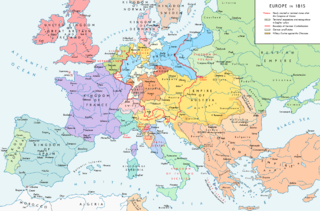 W
WThe Concert of Europe refers to a general consensus among the Great Powers of 19th Century Europe to maintain the European balance of power and the integrity of territorial boundaries. Never a consensus, and subject to disputes and jockeying for position and influence, the Concert represents an extended period of relative peace and stability in Europe following the Wars of the French Revolution and Napoleonic Wars which had consumed the continent since the 1790s. It is typically divided into two phases with different dynamics, the first from 1815 to the early 1850s or 1860s, and the second from the early 1880s to 1914.
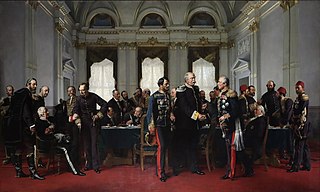 W
WThe Congress of Berlin was a meeting of the representatives of the era's six great powers in Europe, the Ottoman Empire and four Balkan states. It aimed at determining the territories of the states in the Balkan Peninsula after the Russo-Turkish War of 1877–78 and came to an end with the signing of the Treaty of Berlin, which replaced the preliminary Treaty of San Stefano, which had been signed three months earlier between Russia and the Ottoman Empire.
 W
WThe Hague Congress or the Congress of Europe, considered by many as the first federal moment of the European history, was held in The Hague from 7–11 May 1948 with 750 delegates participating from around Europe as well as observers from Canada and the United States of America.
 W
WThe Entente Cordiale was a series of agreements signed on 8 April 1904 between the United Kingdom and the French Republic which saw a significant improvement in Anglo-French relations. Beyond the immediate concerns of colonial expansion addressed by the agreement, the signing of the Entente Cordiale marked the end of almost a thousand years of intermittent conflict between the two states and their predecessors, and replaced the modus vivendi that had existed since the end of the Napoleonic Wars in 1815 with a more formal agreement. The Entente Cordiale was the culmination of the policy of Théophile Delcassé, France's foreign minister from 1898, who believed that a Franco-British understanding would give France some security against any German system of alliances in Western Europe. Credit for the success of the negotiation belongs chiefly to Paul Cambon, France's ambassador, and to the British foreign secretary, Lord Lansdowne.
 W
WThe European Civil War is a concept meant to characterize a series of 19th- and 20th-century conflicts in Europe as segments of an overarching civil war within a supposed European society. The timeframes associated with this European Civil War vary among historians. Some descriptions range from 1914 to 1945, thus including World War I, World War II, and many lesser conflicts of the interwar period. Others argue that this period started in 1870 with the Franco-Prussian War, or in 1905. Sometimes, the notion also serves to explain or justify the process of European integration and the creation of the European Union as a "solution" to this conflict.
 W
WA favourite (British) or favorite was the intimate companion of a ruler or other important person. In post-classical and early-modern Europe, among other times and places, the term was used of individuals delegated significant political power by a ruler. It was especially a phenomenon of the 16th and 17th centuries, when government had become too complex for many hereditary rulers with no great interest in or talent for it, and political institutions were still evolving. From 1600 to 1660 there were particular successions of all-powerful minister-favourites in much of Europe, particularly in Spain, England, France and Sweden.
 W
WThe Golden Twenties, also known as the Happy Twenties, is the decade of the 1920s in Germany. The era began with the end of World War I and ended with the Wall Street Crash of 1929.
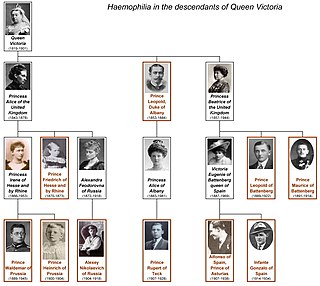 W
WHaemophilia figured prominently in the history of European royalty in the 19th and 20th centuries. Britain's Queen Victoria, through two of her five daughters, Princess Alice and Princess Beatrice, passed the mutation to various royal houses across the continent, including the royal families of Spain, Germany and Russia. Victoria's youngest son Prince Leopold, Duke of Albany, also suffered from the disease, though none of her three elder sons did. For this reason, haemophilia B was once popularly called "the royal disease". Tests on the remains of the Romanov imperial family show that the specific form of haemophilia passed down by Queen Victoria was probably the relatively rare Haemophilia B.
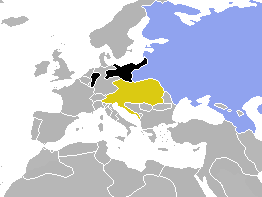 W
WThe Holy Alliance was a coalition linking the monarchist great powers of Austria, Prussia, and Russia. It was created after the final defeat of Napoleon at the behest of Emperor (Tsar) Alexander I of Russia and signed in Paris on 26 September 1815. The alliance aimed to restrain liberalism and secularism in Europe in the wake of the devastating French Revolutionary Wars and the Napoleonic Wars, and it nominally succeeded in this until the Crimean War. Otto von Bismarck managed to reunite the Holy Alliance following the unification of Germany in 1871, but the alliance again faltered by the 1880s over Austrian and Russian conflicts of interest over the dissolution of the Ottoman Empire.
 W
WThe Industrial Revolution, now also known as the First Industrial Revolution, was the transition to new manufacturing processes in Europe and the United States, in the period from about 1760 to sometime between 1820 and 1840. This transition included going from hand production methods to machines, new chemical manufacturing and iron production processes, the increasing use of steam power and water power, the development of machine tools and the rise of the mechanized factory system. The Industrial Revolution also led to an unprecedented rise in the rate of population growth.
 W
WIntermarium was a geopolitical project conceived by politicians in successor states of the former Polish–Lithuanian Commonwealth in several iterations, some of which anticipated the inclusion as well of other, neighboring states. The proposed multinational polity would have extended across territories lying between the Baltic, Black and Adriatic Seas, hence the name meaning "Between-Seas".
 W
WThe Little Entente was an alliance formed in 1920 and 1921 by Czechoslovakia, Romania and the Kingdom of Serbs, Croats and Slovenes with the purpose of common defense against Hungarian revanchism and the prospect of a Habsburg restoration. France supported the alliance by signing treaties with each member country. The rapid growth of German power caused its collapse in 1938, and it never went into wartime operation.
 W
WMenace in Europe: Why the Continent's Crisis Is America's, Too is a book by Claire Berlinski about problems and challenges facing Europe, and the consequences of Europe's failure to meet these challenges. Among the phenomena addressed in the book are Muslim integration, anti-Americanism, antisemitism, and Europe's often forgotten violent history.
 W
WIn historical contexts, New Imperialism characterizes a period of colonial expansion by Western European powers, the United States, Russia and Japan during the late 19th and early 20th centuries. The period featured an unprecedented pursuit of overseas territorial acquisitions. At the time, states focused on building their empires with new technological advances and developments, expanding their territory through conquest, and exploiting the resources of the subjugated countries. During the era of New Imperialism, the Western powers individually conquered almost all of Africa and parts of Asia. The new wave of imperialism reflected ongoing rivalries among the great powers, the economic desire for new resources and markets, and a "civilizing mission" ethos. Many of the colonies established during this era gained independence during the era of decolonization that followed World War II.
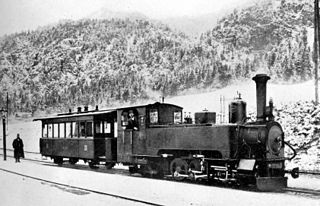 W
WThe Second Industrial Revolution, also known as the Technological Revolution, was a phase of rapid standardization and industrialization from the late 19th century into the early 20th century. The First Industrial Revolution, which ended in the middle of 19th century, was punctuated by a slowdown in important inventions before the Second Industrial Revolution in 1870. Though a number of its events can be traced to earlier innovations in manufacturing, such as the establishment of a machine tool industry, the development of methods for manufacturing interchangeable parts and the invention of the Bessemer process to produce steel, the Second Industrial Revolution is generally dated between 1870 and 1914.
 W
WThe Warsaw Treaty Organization (WTO), officially the Treaty of Friendship, Cooperation and Mutual Assistance, commonly known as the Warsaw Pact (WP), was a collective defense treaty signed in Warsaw, Poland between the Soviet Union and seven other Eastern Bloc socialist republics of Central and Eastern Europe in May 1955, during the Cold War. The Warsaw Pact was the military complement to the Council for Mutual Economic Assistance (CoMEcon), the regional economic organization for the socialist states of Central and Eastern Europe. The Warsaw Pact was created in reaction to the integration of West Germany into NATO in 1955 per the London and Paris Conferences of 1954, but it is also considered to have been motivated by Soviet desires to maintain control over military forces in Central and Eastern Europe.
 W
WWorld War II, also known as the Second World War, was a global war that lasted from 1939 to 1945. It involved the vast majority of the world's countries—including all the great powers—forming two opposing military alliances: the Allies and the Axis. In a state of total war, directly involving more than 100 million personnel from more than 30 countries, the major participants threw their entire economic, industrial, and scientific capabilities behind the war effort, blurring the distinction between civilian and military resources. World War II was the deadliest conflict in human history, resulting in 70 to 85 million fatalities, with more civilians than military personnel killed. Tens of millions of people died due to genocides, premeditated death from starvation, massacres, and disease. Aircraft played a major role in the conflict, including in strategic bombing of population centres, the development of nuclear weapons, and the only two uses of such in war.